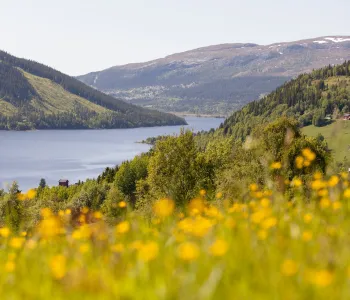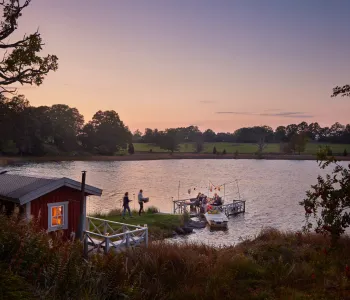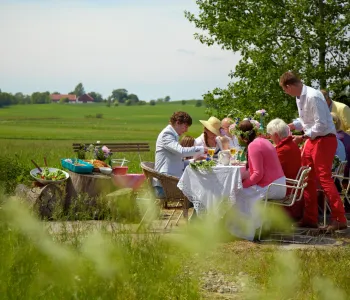
Our countryside and a glimpse at the wildlife
Sweden is well known for its beautiful countryside, which is one of the reasons many foreign visitors give for taking a holiday in Sweden. To give you an overview of some of the typical or unique aspects of the great Swedish outdoors, we have compiled this fun guide from A-Z about the Swedish countryside.
Aurora Borealis (the northern lights)
This is an astronomical phenomenon which occurs near the North and South Poles. When it happens near the North Pole, it is also referred to as the northern lights. The northern lights can appear differently, but often a green colour dominates. It occurs in northern Sweden the whole year round but it is only seen during the winter months when the sky is dark. In northern Sweden, the Aurora has become a tourist attraction and many places have arranged night trips for tourists.
Bear
In Sweden today, around 3000 bears live in the wild. Bears live mainly in the northern half of Sweden, but sometimes search for food further south. Bears are very difficult to discover in the forests and it is very rare that people chance upon a bear. The best way to see a bear in Sweden is to visit one of the animal parks or zoos, for example Orsa Bear Park in Dalarna.
Cloudberry
Cloudberry (‘hjortron’ in Swedish) is sometimes called the gold of the north because it is very common in Norrland. It is there that the most berries are picked each summer. The yellowy orange berry, which is actually a stone fruit, is often used to make jams and preserves. Vanilla ice-cream with cloudberry jam is a much-loved dessert which any visitor to Sweden should not miss.
Fishing
Fishing is popular in Sweden. It is free to fish in the sea and the five big lakes (Vänern, Vättern, Storsjön, Hjälmaren and Mälaren). In all other lakes and waterways, you need a fishing permit. You can usually buy a fishing permit at the tourist office, campsite, or local shops in the area where you want to fish. There is also a Sweden fishing licence, which allows you to fish in more than 800 places in over 40 different local areas.
Hiking
Sweden is a fantastic country for hiking. With over 400 excellent hiking paths, it’s easy to find a path that suits just you. In the south there’s Skåneleden –s a 960 km long trail which snakes its way through the entire Skåne landscape. In the north, there’s Sweden most famous hiking trail, Kungsleden (read more under K). For anyone hiking in Sweden, it’s important to remember the public access rights (read more under P).
Islands
Along Sweden’s coastline are simply tonnes of islands and in many places the islands form individual archipelagos. The most famous are the Stockholm and Gothenburg archipelagos. Stockholm’s archipelago comprises more than 24,000 islands and is easy to access for visitors. Ferries from the city centre go directly to many of the islands. In the Swedish archipelagos there are some habited islands, but most are uninhabited.


Kings Trail
Kings Trail, or Kungsleden as it is known in Swedish, is approximately 425 km and cuts across the Swedish mountains in the north. The trail was first laid at the beginning of the twentieth century and since 1975 the Kings Trail goes between Abisko in the north and Hemavan in the south. The trail is especially popular in the summertime, but even in winter you can hike along some stretches.
Linné
Carl von Linné (1707-78) was one of the foremost Swedish botanists and physicians and became famous the world over following the creation of the “Systema naturae” – the system that is used today for classifying plants, animals, and minerals. In the village of Råshult in Småland in southern Sweden, you can visit the place where Carl von Linné grew up. In Uppsala, where he worked for many years, there is the renowned Linné garden.
Midnight sun
In the north of Sweden, the days get longer and lighter during the spring and from the end of June, the sun doesn’t set. The midnight sun continues all summer and draws just as many tourists to the north of Sweden as the northern lights. During the winter, the opposite happens; the sun doesn’t rise above the horizon for days. This phenomenon is called ‘polar night’.
Moose
For foreign visitors there’s no other animal as closely connected with Sweden as the moose. The moose, which in Sweden is sometimes called the king of the woods, has become a real tourist attraction. In many places across the country, there are special moose parks, where the visitor can come up close to the animals and sometimes even stroke them.
National Parks
In Sweden there are 30 national parks. According to the legislation, the purpose of a national park is to “preserve a larger, connected area of a particular type of landscape in its natural state or in an essentially unspoilt condition”. The government owns the land covered by national parks. Sweden’s national parks include mountain areas, forests, cultivated areas, and the sea. And of course, all national parks are open to visitors.
Reindeer
Reindeer in Sweden today are semi-domesticated and wild reindeer have been extinct since the 1800s. Reindeer can be found in the northern half of the country, from northern Dalarna to Sweden’s most northerly borders. For thousands of years, the Sami people of the north have worked alongside reindeer. It’s difficult to see a reindeer in the wild but there are many to admire at Sweden’s zoo and animal parks, such as Nordens Ark.

Skogsmulle
Many Swedes have once upon a time in their childhood met Skogsmulle. Skogsmulle is a fantasy figure from the Swedish Outdoors Association (SOA), who is said to live in the woods and is tasked with teaching children about nature and taking care of the countryside. Skogsmulle was created in 1957 by Gösta Frohm, an experienced leader within SOA. Even today, there are many groups of children across Sweden, who work in line with the Skogsmulle concept.
Public access rights
Public access rights, or Allemansrätten as it is known in Swedish, is one of Sweden’s four ground laws written in the constitution. In short, it states the Swedish people and visitors are allowed to roam freely in the countryside, irrespective of who owns the land, but are absolutely forbidden to destroy or damage the land or disturb animals or plants. Public access rights do not apply to motor-driven vehicles. For example, you cannot park your caravan in the woods under Allemansrätten.
Water
Almost 10% of Sweden’s area is made up of water, such as lakes, rivers, and marshland. Swedish water is of very high quality and across the whole country you can drink water straight from the tap. You can also drink the water from many mountain streams up in the north, which is very handy for all hikers who prefer not to carry water with them.





